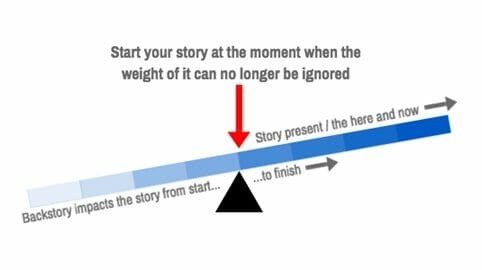My mission as a book coach is to help writers write the best books they can, which means paying attention to:
- the macro elements (the story or argument the book makes)
- the micro elements (the words on the page)
- the emotional realities of the writing life (the habits that lead to success)
I’ve developed a series of posts to help you learn how to write one really great chapter so that you can take those lessons and apply them to all your work.
Post 1 – Yank Your Reader Into Your Story With a Great Opening Line
How to Start Your Book in the Right Place
In order to write a great first chapter for a book, you have to start in the right place.
There are two main ways writers tend to get this wrong:
-
Gearing Up for the Story
They spend pages and pages gearing up for the story — warming up to it, laying the groundwork for it, telling us all the things we need to know in order to understand it, and by the time they start actually telling their tale, they have lost us. We are watching TV instead, or pulling weeds in the flowerbed, or taking the dog for a walk.
“Gearing up” can take many forms. In fiction and memoir:
- Descriptions of the setting
- Descriptions of people
- Descriptions of the weather
- Characters sitting around musing
- Characters sitting around reflecting
- A random prologue that explains a bunch of things that came before the real story
- Info dumps in which the author gives us chunks of backstory, including:
- explanations of childhood
- explanations of parent’s lives
- explanations of dramatic events from the past
- reasons the character is doing that they are doing
We don’t need any of these things at the start of a story. What we want is something happening RIGHT NOW, in story present, in real time, in THIS moment. We want a reason to care NOW and we want to know what’s in it for us NOW.
That means we have to know whose story it is, what matters to her on a deep soul level, what’s at stake, what she stands to lose, and what keeps her up at night. We do not need to know the color of her hair or the lay of the land.
As for backstory, instead of dismissing this as simply “what comes before the story starts” think of it instead as everything that comes before the story starts that makes this person who they are. The backstory is the character’s DNA. It’s how she sees the world, how she moves through it. It will be revealed in every single thing she says or does or decides. Backstory, therefore, shouldn’t be delivered in chunks because that is not its nature; it should be inherent in the story itself, and should be delivered in how the character moves and talks and thinks and remembers, and how she makes sense of whatever is happening to her.
In non-fiction, “gearing up” might include:
- A defense for why the author believes he has a right to speak about the topic at hand
- An exhaustive explanation of why writing a book seemed like a good idea
- A chronology of everything in their entire life that led up to the author having the knowledge they would like to now share
We don’t need any of these things at the start of a book. What we need is to know:
- What’s in it for us?
- What we stand to gain if we read this book.
- How our lives will change as a result.
- Will we be educated, enlightened, empowered, amused?
- How will we be transformed?
In other words, it’s all about us, not you. Your job is to give us a reason to care.
That being said, in non-fiction (well, actually in fiction, too), we want to feel like we are in the hands of an authority. We need to be able to trust you. So SOME information about why you are speaking to us on this topic, and SOME information about your credentials and point of view is welcome, as long as it is not defensive, apologetic, or exhaustive.
The Fix
Whether you are writing fiction, memoir, or non-fiction, if you fear that you have spent even one paragraph gearing up to tell your story, let alone a page or a whole chapter, ax it out. Just slash it away. Pinpoint the place where your story or your book REALLY starts, and just start there, with confidence and authority.
A story starts at the moment the weight of it in the character’s life (or in our own lives, if we are a reader of non-fiction) can no longer be ignored. The wolf is at the door RIGHT NOW. The teeter-totter is about to tip.
-
Dropping the Reader into High Action or Drama
The second thing writers tend to get wrong at the start of a book is that they drop us into a moment of high action or drama and assume that we know why we should care. Bombs are going off, a timer is ticking down to disaster, someone is on the verge of death, aliens are invading from Pluto, there is an intense and dramatic conversation happening – but we have no context, no understanding of why any of it matters to anyone, and therefore no reason to care. (And yes, non-fiction writers do this, too – well, not the thing about Pluto.)
There’s nothing more frustrating for a reader than being left out. Stuff is happening – okay, yes, we can see that — but we don’t get it. And we hate that. It makes us feel stupid.
Assuming too much can take many different forms:
- Physical danger that completely ignores who, exactly, is in danger or what’s at stake for them at this moment in their lives
- Fast-moving action with no context
- Fast-moving dialogue with no subtext
Action alone is not interesting. Action alone is just a bunch of random events. We come to story to feel what it’s like to be in someone else’s skin – even if that person is James Bond or Jason Bourne or Batman. You can go on to have all kinds of high drama, but at the start of a story, we want to know why we should care, which takes us back to the exact same elements we discussed above.
The Fix
For fiction and memoir:
- Give us someone specific who sees the world in a specific way (that’s her DNA, her backstory that will inform the whole story.)
- Let us know what she wants and why.
- Let us know what is standing in her way of getting it – both externally (aliens, bombs, bad guys) and also internally (self-doubt, self-loathing, moral confusion.)
- Let us know what will happens if she doesn’t get this thing she wants.
- If you open with dialogue, don’t make us guess what we are reading; infuse it with subtext and meaning.
For non-fiction:
- By all means, dramatize the impact of how we may be transformed, but make sure we have the context.
- If you are showing us the “before” or the “after” in scene form or story form, make sure we know what we are reading, and why we should care.
- If you open with dialogue, don’t make us guess what we are reading; infuse it with subtext and meaning.

Examples
How to Start Your Book in the Right Place – Fiction Example
How to Start Your Book in the Right Place – Nonfiction Example
Your story starts at the moment we begin to care, but it’s hard to care if we don’t have any idea what’s going on. Get the meaning and context on the page, and you’ll have a fighting chance of holding your reader’s attention.
Photo: pixabay.com


